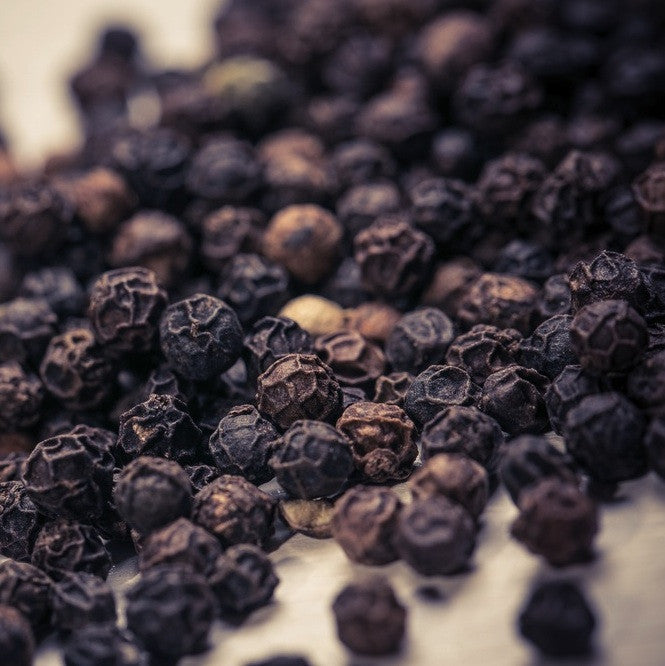TIMELESS Essential Oils
Black Pepper, Organic
Couldn't load pickup availability
Pure, Therapeutic Black Pepper, Organic
Product Details
Botanical name
Piper nigrum
Aroma
Spicy, peppery with herbaceous undertones, warm, musky
Note
Middle
Odor Intensity
3
Key constituents
Beta-caryophyllene, d-3-carene, limonene, alpha-pinene
Extraction method / Source
Steam distillation / Fruits
Plant description
Botanical family: Piperaceae
Black Pepper is a tropical climbing vine native to India. The plant grows to a height of about 10 feet and has clusters of small white flowers. As the berries ripen, they turn from green to orange to red. After the berries are picked they are left in the sun to dry, which turns their color to black.
Regions of Production
Madagascar
Growing Practices
Organically farmed. Plants are tested after harvest for purity.
Properties
Analgesic, antiseptic, antispasmodic, carminative, diaphoretic, diuretic, febrifuge, laxative, rubefacient, stomachic, tonic (Battaglia, 2003), natural insect repellent
Please refer to the Glossary for terms which may be new to you.
Uses / Benefits
Warming and helpful for relieving pain and increasing circulation, loosens tight muscles, aids digestion in small amounts. Increases the benefits of other oils that are used together with Black Pepper. It improves mental clarity and is invigorating and refreshing. Black Pepper essential oil is also used in small amounts in natural perfume making.
Beneficial in supporting smoking cessation
See additional smoking cessation options: Calming Black Pepper Synergy Blend, Energizing Black Pepper Synergy Blend and Refillable Aluminum Nasal Inhalers
Modes of Administration
Topical: massage, compress, bath, skin care
Inhalation: direct inhalation or aromatherapy inhaler
Fragrant influences
Improves mental clarity, invigorating, refreshing
Blends well with
Bergamot, Clary Sage, Cedarwood, Clove, Coriander, Fennel, Frankincense, Geranium, Ginger, Grapefruit, Juniper, Lavender, Lemon, Lemongrass, Lime, Mandarin, Marjoram, Myrrh, Orange, Palmarosa, Rosemary, Sage, Sandalwood, Tea Tree, Ylang Ylang
Safety
Generally recognized as safe (GRAS). Non-toxic, non-sensitizing. May irritate sensitive skin. (Battaglia, 2003, US Food and Drug Administration)
Notice
This information is for educational purposes only. It has not been evaluated by the US Food and Drug Administration. This information is not intended to diagnose, treat, cure or prevent any condition or disease and should not take the place of evaluation by a qualified health professional. Although we strive to provide information which is accurate and up to date, we cannot guarantee the accuracy or completeness of this information.
Precautions
Pure essential oils are highly concentrated plant extracts. Do not use them undiluted, or in the eyes or mucus membranes. If applying an essential oil to the skin, always dilute it with a proper carrier oil and test on a small patch of skin before applying to a large area. Do not take them internally except under the direction of a qualified professional trained in Aromatherapy. Always familiarize yourself with the safety, contraindications and proper preparation of each essential oil before use. Note that when using essential oils for children and the elderly, very low concentrations should be used. Keep all essential oils away from children and pets.
References
Battaglia, Salvatore, The Complete Guide to Aromatherapy, Second Edition, 2003. The International Centre of Holistic Aromatherapy, Brisbane, Australia
International Fragrance Research Association, http://www.ifraorg.org/en-us/standards (January 5, 2016)
Schnaubelt, Kurt, Advanced Aromatherapy: The Science of Essential Oil Therapy, (English translation)1998. Healing Arts Press, Rochester, VT.
Tourles, Stephanie L., Hands On Healing Remedies, 2012. Storey Publishing, North Adams, MA.
United States Food and Drug Administration, HHS, 182.1 Substances That Are Generally Recognized as Safe, 182.20 Essential oils, Oleoresins (solvent-free), and natural extractives (including distillates), http://www.gpo.gov/fdsys/CFR-2012-title21-vol3-sec182 (January 28, 2016
Williams, David G., The Chemistry of Essential Oils, 1996. Micelle Press, Dorcet, England
Worwood, Valerie Ann, The Complete Book of Essential Oils & Aromatherapy, 1991. New World Library, Novato, California
TIMELESS Essential Oils guarantees the purity and quality of all our therapeutic oils. The current Certificate of Analysis is available upon request. All essential oils are best stored in an airtight container away from heat and light.


